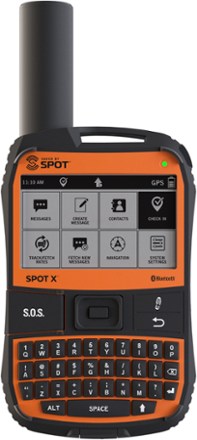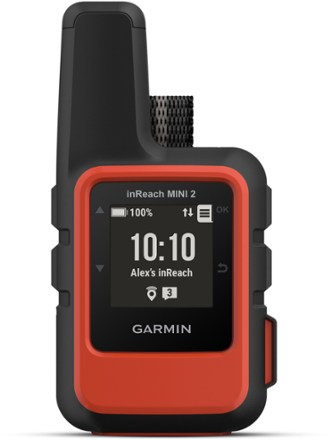
Satellite Messengers For Hikers:
Stay Found & Connected
Using One On A Hike
By Diane Spicer
Satellite messengers for hikers at first glance seem like a no brainer.
Who wouldn't want to carry a communication device that can help you out of a jam?
Oh wait, isn't that your smart little cell phone?
Here's the short list of pivotal question to ask yourself if you trust in your phone:
- Will cell phone coverage be reliable where you're going?
- Will it be spot on (a bit of foreshadowing) at the instant you might need it?
- Does your cell phone hold its charge reliably in cold, wet conditions?
- Do you always leave for a hike with 100% charge?
Enter satellite messengers, which are way more than just portable hand held devices for sending an SOS for rescue from nasty circumstances.
Skip the cellular connection game (will I or won't I have a signal?) and tap into the power of satellite networks.
Or skip directly to the recommendations.
Satellite messengers:
the details for hikers
Satellite Emergency Notification Devices (SEND) are much different from a panic button device like a Personal Locator Beacon.
The benefits of emergency satellite messenger devices for hikers can include:
- One-way message sending (as in "Hey, I'm fine").
- Two-way messaging, meaning you can communicate not only your where abouts with loved ones at home, but also update them and answer questions, or synch up with trail buddies.
- The device can track you, making you visible to folks interested in your hiking progress.
- It can send an SOS message when everything hits the fan.
- The battery life is reasonably long, although cold conditions will cut into battery performance.
Drawbacks of satellite messengers
These devices are not cheap.
- Only you can decide if the investment makes sense for your style of hiking.
You have to pay to play. In other words, add a subscription fee, and sometimes annual plan charges and activation fees, to your hiking budget.
If you're a frequent hiker, a yearly fee makes sense. If you're not, look for a monthly fee or reasonable data plan.
An unobstructed view of the sky is necessary before trying to send or receive a message.
- If you hike in areas where this isn't possible (deep forests or rocky canyons), the device will be useless to you.
Time lags between "send" and "receive" may occur as the satellites acquire signal, cutting down the effectiveness of the messages when time is of the essence.
- If you're just sending a weekly check in as you backpack the PCT, no problem.
Messages may not send, depending on your ability to access the satellites and the strength of the signal.
- This creates stress in the people expecting an "all okay" message - the exact opposite of your intent.
- It may also give you a false sense of security, thinking help is on the way when it isn't (yet).
You're going to have to do
some careful research before purchasing one of these gizmos, because not
every one of them does every thing listed above.
Decide what's most important to you, and then buy the device that excels in those things:
- messages
- tracking
- rescue
Or all three.
Satellite messengers
make total sense when...
...you are doing a hike or backpacking trip that folks back home are not completely on board with.
One example: a solo female hiker who is navigating unfamiliar trails or going into the backcountry, with anxious nail biters back home.
Another example:
Being part of a group trip through remote areas where bear encounters, fierce weather, and challenging terrain up the risk factors of the trip.
- If helicopter rescue is the only way out, you need at least one reliable device that can communicate with the proper authorities.
- These satellite messengers are cheaper than sat (satellite) phones and easier to transport.
Personal note: When I consider signing up for a hiking trip being guided through remote areas, I always ask about the type of satellite messenger (or satellite phone, an expensive option that I don't recommend to individual hikers) they will be providing.
You should, too!
- Tip: Joining a guided group makes you eligible for trip insurance, meaning that the cost of helicopter evacuation may be covered. Look into it!
Which device?
Recommendations for satellite messengers
for hikers
 SPOT X with Bluetooth | REI Co-op SPOT X with Bluetooth | REI Co-op
|
Here's a lightweight, easy to use device which can be motion activated or set on continuous usage as you hike. See the prominent SOS button? If that's your primary interest, check out this one. |
Benefits to using this satellite messenger device:
- It's easy to use. That's worth its weight in gold, because if you are befuddled by the buttons, or have to remember a lot of technical details each time you turn it on, you're not going to use it (correctly).
- Reliability is high,
given the field testing done with it. You don't want to be hiking
along, thinking that your messages have been sent, when they have not
been. However, this reliability depends on your location, so results may vary for you.
- You can use the Bluetooth connectivity on your phone to make sending messages easier.
- You can blast off an SOS message, or use one of14 standard messages.
- You can text with the folks back home without relying upon sketchy cell phone coverage (satellites, right?).
- Sharing your GPS coordinates allows them to follow your progress, and share your location with search & rescue personnel if necessary.
- With reasonably long operating life (240 hours), it's a mere 7 ounces - until you add the fully charged lithium batteries.
Do your own background research, read reviews, and know what you're signing up for when you decide to purchase a SPOT.
An additional SPOT Service Plan is required for operation, so factor that into your hiking budget as you compare devices.
Worried about size and weight?
This tiny Garmin two-way communication device weighs 3.5 ounces, yet gives you tracking and SOS capabilities, plus access to weather forecasts.
- Two way messaging
- Interactive SOS capable
- Tracking features
A subscription plan is required, so add that to the yearly cost.
Decision time...
Ask yourself:
Do you want to be able to send and receive messages while hiking?
Do you want to make yourself "trackable"?
Are you going into areas where an SOS rescue is more than a faint possibility?
How much is the "luxury" of communication worth to you?
- Not only in terms of money, but in terms of weight, ease of use, reliability and peace of mind?
These are questions only you can answer!
If all you want is a panic button for an emergency rescue, consider carrying a personal locator beacon.
But if you want communication, tracking, AND rescue messaging, satellite messengers are here for you.
Stay safe, hike smart, enjoy your backcountry adventures, and use technology wisely!
And may the satellites always align quickly for you.
 Perfect! No cover so the satellites can quickly do their thing
Perfect! No cover so the satellites can quickly do their thingHome page > Best Hiking Gear >
Satellite Messengers For Hikers
|
I get emails all the time about what I wear, eat, carry and love to use on the trail. That's
why I provide affiliate links to you: the best gear that I use myself and have seen used by other hikers is instantly
available for your consideration, and the gear company sends a few
pennies per dollar to this reader-supported hiking website. There is no added cost to you! Everyone ends up a winner: Great gear for you, strong gear companies, and more free hiking tips for everyone. Thanks very much for your support. It's warmly and sincerely appreciated. It also helps send these hiking tips to all your virtual trail buddies around the globe. |
 |



